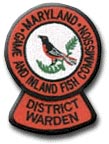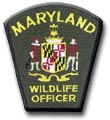

The Maryland Natural Resources Police are descendants of both the State Oyster
Police, created in 1868 and the Office of the State Game Warden, created in 1896.
Additionally, in 2005 law enforcement duties on DNR Public Lands were transferred from the State Forest and Park Service to the Natural Resources Police. A
total of 91 former law enforcement Rangers were added to the ranks of the NRP bringing the total sworn force to 244.
In the early years of the nineteenth century, Maryland’s oyster resources were being depleted as the result of harvesting pressure. After ravaging the northern oyster beds in the territorial waters of Delaware, Connecticut and Rhode Island, New England schooner fleets were harvesting the oysters of the Chesapeake Bay and its tributaries. In response,the Maryland General Assembly passed a law in 1830 to restrict the harvesting of Maryland oysters to the benefit of Maryland residents only. While this measure was a necessary first step, it was largely ineffective due to the lack of viable enforcement. Additional legislation was passed in 1865, requiring oyster harvesters to purchase an annual license. Again, since implementation of the law depended upon local authorities without the capability to enforce water-related violations, the law did little to help regulate the oyster resource in Maryland.

|
Realizing the need for enforcement within the State to protect the
Chesapeake oyster grounds, the Maryland General Assembly in 1868
created the State Oyster Police whose exclusive responsibility was the
enforcement of oyster laws on the Chesapeake Bay. During that same
year, Hunter Davidson, a graduate of the United States Naval Academy
and former Lt. Commander in the Confederate States Navy, was
unanimously elected by the State Board of Commissioners as the first Commander of the
State Oyster Police Force.
|

|
With the exception of oysters, Maryland’s fisheries resources were initially overlooked
by the General Assembly. In 1874, a Commission of Fisheries was created to study and
submit a report on the status of Maryland’s fisheries resources. The State Oyster Police
Force was brought under the jurisdiction of the new Commission and renamed the State
Fishery Force.

In 1890, formal conservation of Maryland’s natural resources began when the first laws for uniformity in the protection of game birds and game animals were placed on the statute books by the General Assembly. Prior to 1890, an unenforceable assortment of county game and fish legislation made protection of natural resources both cumbersome and ineffective. The problems created by local game legislation incited sportsmen to assert themselves. Pressure on the legislature brought about the Act of 1896, which created the Office of the State Game Warden. It further required the governor to appoint a state game warden for Maryland every two years. Governor Lloyd Lowndes appointed Robert H. Gilbert, as Maryland’s first State Game Warden. He received a small salary along with all fines rising from the violations of the game and fish laws.

Untitled Document
In 1916, the Conservation Commission was created combining the
State Fisheries Force and the Office of the State Game Warden. The
Conservation Commission was empowered by the legislature to
appoint the state game warden, thus relieving the governor of this
responsibility. The Commission’s first appointment was E. Lee
LeCompte, President of the Dorchester County Fish and Game
Protective Association, who served as State Game Warden until
1945.

In 1918, after only two years in office, LeCompte's administration was
instrumental in enacting the first statewide hunting license law. State
officials anticipated that the licensing requirements would generate
approximately $35,000 the first year, but it actually produced revenue of
$61,770.43. During this time, one game warden was assigned to three
counties to enforce the fish and game laws. Nine years later in 1927, the
legislature enacted the resident and nonresident angler’s license, which was required by
all persons over the age of 14 desiring to fish the non-tidal waters of the state.
Periodically, the Commission performed important secondary functions. Shortly after the
United States formally issued a declaration of war in August of 1917 for World War I, all
vessels of the State Fishery Force were designated as a unit of the U.S. Navy, Squadron
Eight, Fifth Naval District. Agency personnel were enrolled in the United States Naval
Reserve, and its vessels were leased to the federal government. They were ordered to
patrol their respective districts in order to enforce federal laws in addition to state
conservation laws. Control of personnel and vessels by the U.S. Navy was returned
to the State Fisheries Force in 1918.

In 1920, with the passage of the 18th Amendment regarding Prohibition, the State
Fishery Force was assigned to patrol the Chesapeake Bay and apprehend rumrunners
who were smuggling contraband liquor into Maryland by way of the Chesapeake Bay
and its tidal tributaries.
In 1922, Governor Albert C. Ritchie created a one-man commission called the State
Conservation Department. Harrison Vickers was the first commissioner appointed under
Governor Ritchie's "Conservation Reorganization Act,” and upon the expiration of
Vickers' term on June 1, 1924, Governor Ritchie appointed Swepson Earle as
Conservation Commissioner. Swepson Earle had already accomplished significant work
related to the Chesapeake Bay and its resources. He completed the first survey of the
oyster bars of Maryland in 1907 and drew up the Potomac River Compact of 1912. The
reorganization and change of direction in Maryland's conservation program incorporated
the State Fishery Force into its overall activity and calling them the Maryland Patrol and
Inspection Fleet. The reorganization also included game enforcement with a force of 24
salaried District Deputy Game Wardens and 600 Fee Deputy Game Wardens. The
unpaid Deputy Game Wardens were compensated with half the fines while the other half
went to the county roads or schools.
Another title change occurred in 1935, with the Conservation Department becoming the
Conservation Commission. In 1937 the patrol vessel Kent and several other patrol boats
of the State Fishery Force were armed with .30 caliber machine guns for the purpose of
maintaining order on Maryland oyster grounds. During the administration of Governor
Herbert O’Connor, the Conservation Commission was divided to form the Game and
Inland Fish Commission, and the Tidewater Fisheries Commission.
The Board of Natural Resources was created in 1941 as an umbrella organization for all
state conservation agencies. However, the Board of Natural Resources had little or no
control over the individual units like the Game and Inland Fish Commission and the
Tidewater Fisheries Commission. During the 1940s, Tidewater Fisheries Inspectors
observed many changes in the organization. In 1944, the first radiotelephones were
installed on patrol boats, and formal law enforcement training was implemented for
inspectors. In 1947, the Tidewater Fisheries Commission obtained its first aircraft, an
amphibious airplane. At this time the Tidewater Fisheries fleet consisted of 40 vessels
and 97 men, who were entrusted with enforcing Maryland’s oyster, clam, fish, and crab
laws. Meanwhile the Game and Inland Fish Commission increased its force to 53 game
wardens, which enforced the state’s hunting and non-tidal fishing laws. District game
wardens were required to provide their own transportation, as it was not until 1958 that
they were provided with vehicles.

By 1959, the duties and responsibilities of a Maryland game warden were very
diverse, with law enforcement representing only a small part of the increasing
workload. The majority of a warden’s time was spent on predator control, game
trapping and release, distribution of game, assistance in the maintenance and
construction of buildings, repair and maintenance of departmental equipment,
emergency winter feedings, collection of creel data, assistance on pond and lake
reclamation, guided tours for special interest groups, and the collection and
distribution of hunting and fishing licenses.
In 1960, the State Boat Act was enacted. The Boat Act significantly increased the duties
and responsibilities of Tidewater Fisheries Commission as well as Game and Inland Fish
Commission conservation officers. In 1962, the enforcement division of the Tidewater
Fisheries Commission was renamed the Maryland Marine Police, and on March 25, 1963,
the Maryland State Marine Police Academy officially opened on Kent Island with a first
class of eight officers.

The Acts of 1968, Chapter 74, changed the title of game warden to wildlife officer.
During that same year, wildlife officers were granted law enforcement authority equal to
that of other police officers of the state.

On July 1, 1971, a legislative act of the Maryland General Assembly created the Natural
Resources Police by combining the Marine Police and the Wildlife Law Enforcement
Division. The Natural Resources Police Force was comprised of two divisions: the
Inland Division responsible for the enforcement of laws and regulations pertaining to
wildlife and non-tidal fishing activity, and the Marine Division responsible for the
enforcement of conservation laws on tidal waters as they relate to commercial and
recreational fisheries. Both divisions had the responsibility of enforcing the State Boat
Act.
In 1971, the Natural Resources Police had 185 full-time sworn officers
(61 Inland Division and 124 Marine Division), five cadets, and 20 parttime
officers assigned to the Marine Division. The agency’s primary
function became law enforcement, and its law enforcement
responsibilities were growing at a much faster rate than its manpower.
In 1976, the Natural Resources Police initiated a mandatory Hunter
Safety Education requirement whose purpose was to promote
competency in the use of firearms and hunter safety through
mandatory hunter education. The law specifically stated that on or
after July 1, 1977, a person under the age of 18 years of age could not
procure a hunting license or hunt in Maryland unless first issued a
certificate of competence in firearms and hunter safety. It further
stated that on or after the same date, a person, regardless of age could not procure a
hunting license without producing a certificate of competency or a hunting license issued
prior to July1, 1977, or making out an affidavit that the person had such a license.
In 1981, marine and inland personnel were united on a regional basis under the command
of a single regional commander for more cooperative and streamlined enforcement effort.
Although the number of officers working as specialists in their specific areas of
conservation enforcement remained constant, the increased flexibility in the deployment
of personnel and material resources under a single regional commander enhanced the
agency’s efficiency and effectiveness.
The Chesapeake Bay Sport Fishing License law was enacted in 1985,
and in the same year the Department of Natural Resources placed a
moratorium on the catching of Maryland’s state fish, striped bass.

In 1987, the Boating Safety Education Law requirement was enacted
which required that a person born on or after July 1, 1972, could not
operate a numbered pleasure vessel on the waters of Maryland without first obtaining a
certificate of boating safety education. It was the first mandatory boating safety
education law of its kind in the United States; over time, it would result in the
certification of all operators of Maryland registered recreational vessels.
In 1995, the Department of Natural Resources implemented a moratorium on the hunting
of migratory Canada geese. This moratorium was later lifted beginning with the
2001/2002 hunting season.
In 1996, the Natural Resources Police implemented the Reserve Officer Program. This
program now consists of nearly 200 dedicated volunteers who give their time and
expertise helping with boating and hunter education, public relations details,
administrative assistance, and a number of other activities that help the Natural Resources
Police meet their mission and serve the citizens of Maryland.

In 2003, the Natural Resources Police celebrated its 135th Anniversary in conservation
law enforcement. The Maryland Natural Resources Police, Maryland’s oldest state law
enforcement agency, and one of the oldest conservation law enforcement organizations in
the United States, reflects upon a great deal of history and tradition as it enters its third
century of service to Maryland.
In 2005, Governor Robert L. Ehrlich, Jr. implemented one of the recommendations of
the Mandel Commission to streamline State government. A memorandum of
understanding between the Natural Resources Police and the State Forest and Park
Service transferred law enforcement responsibility for all DNR Public Lands to NRP.
Public Land Management remains the responsibility of Park and Forest Managers. Most
of the former law enforcement Rangers transferred to NRP and became Natural
Resources Police Officers. Sworn personnel in NRP now total 244 along with a
dedicated staff of 78 civilian employees.